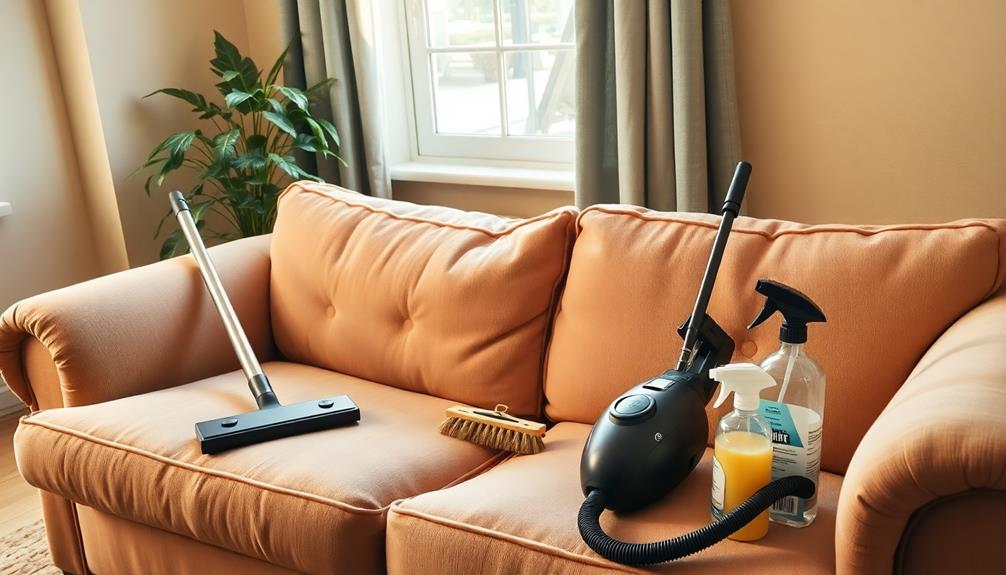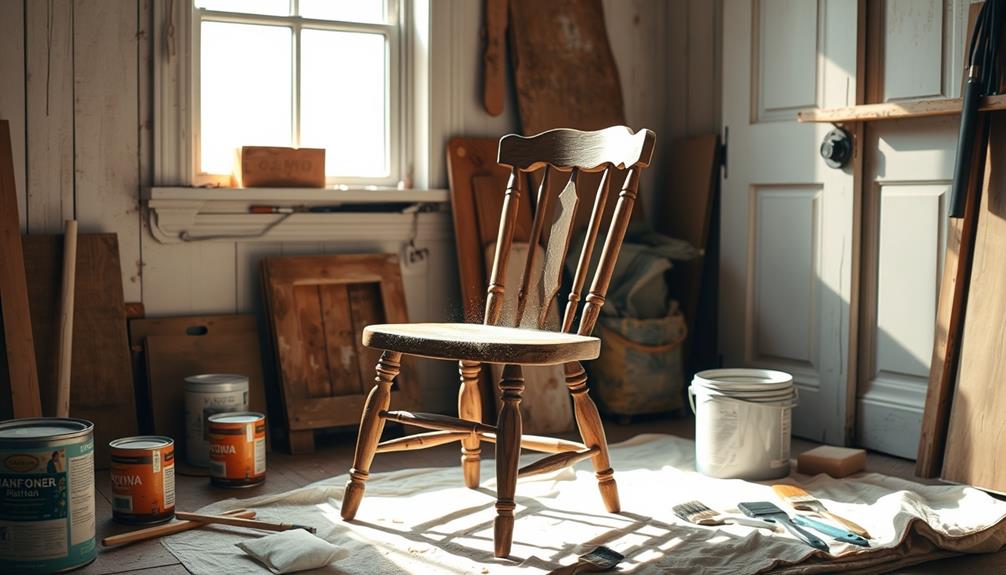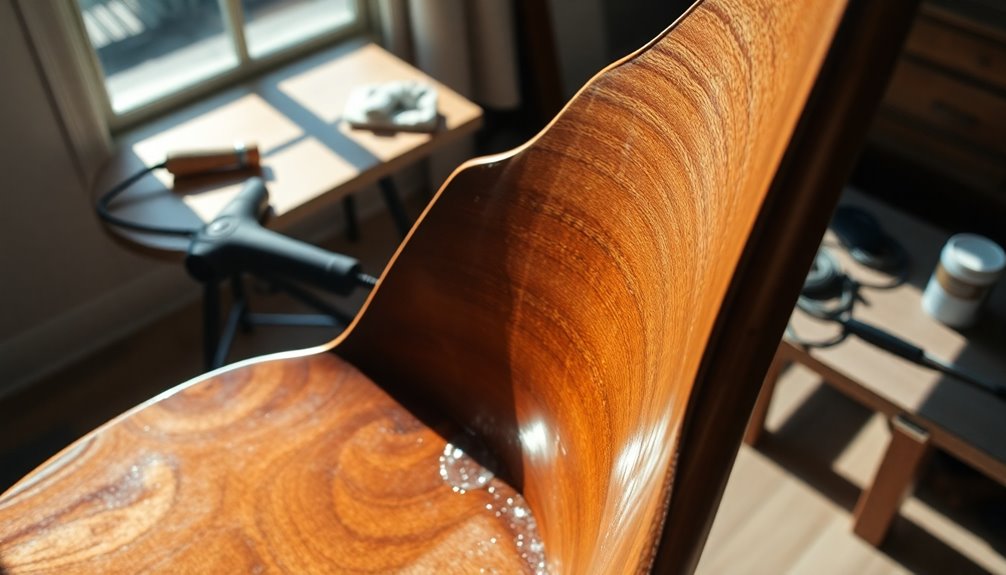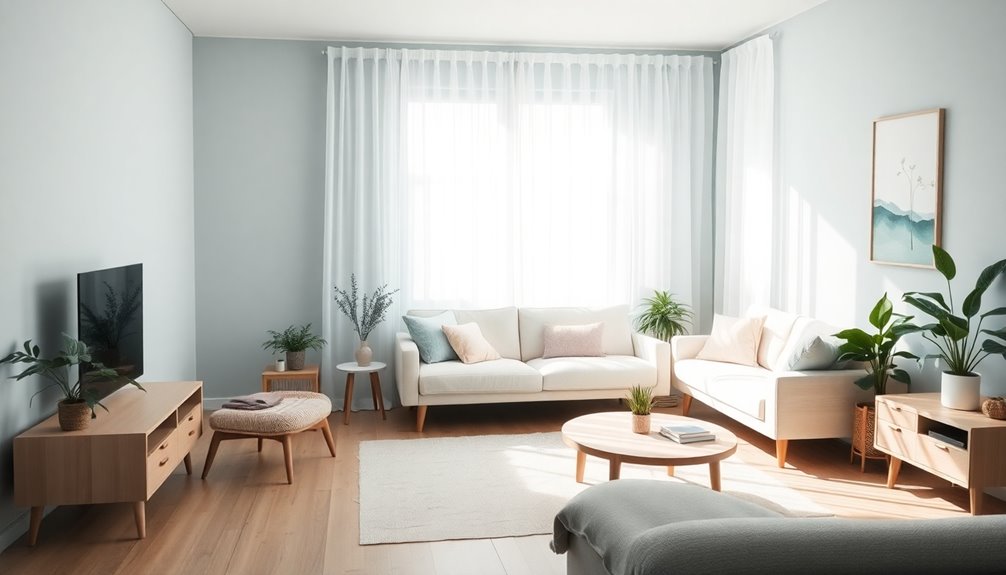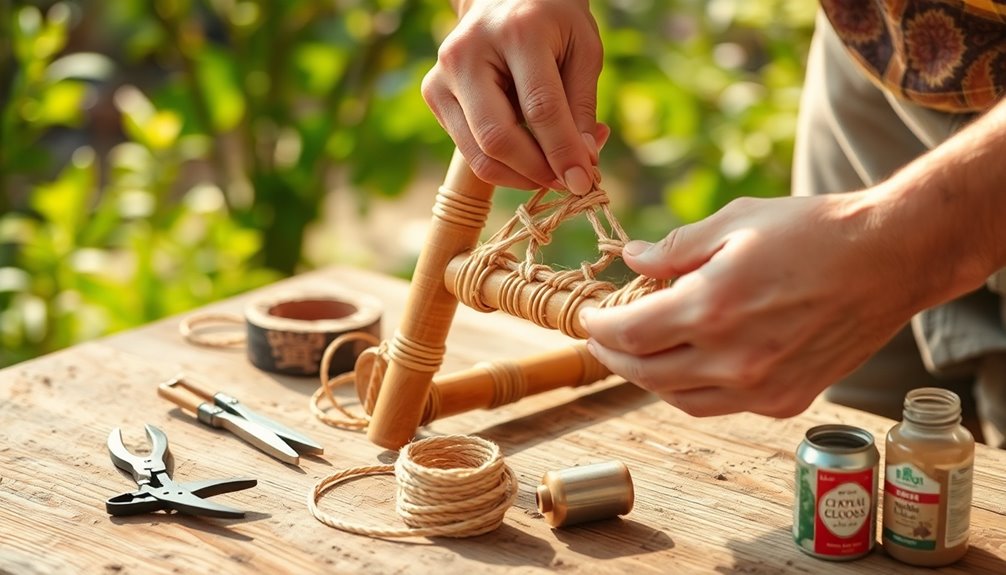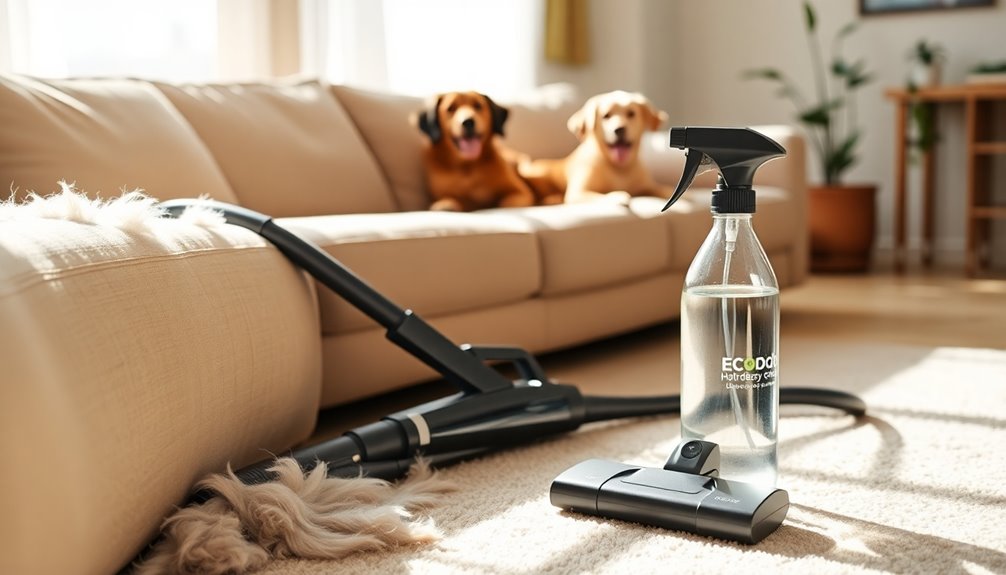To deep clean your sofa, start by removing all items and cushions. Vacuum thoroughly, focusing on crevices and seams. Check the fabric care code for appropriate cleaning methods, then gather supplies like baking soda, a DIY cleaner, and microfiber cloths. For fabric sofas, scrub with a mixture of water, vinegar, and mild detergent. Use baking soda to absorb odors. If you have leather or microfiber, use suitable cleaners to avoid damage. Finally, air dry completely and fluff your cushions. Stick around for tips on maintaining that fresh look and further cleaning techniques that can enhance your routine. To maintain your sofa’s cleanliness, make it a habit to vacuum regularly and spot clean any stains as they occur. Regular **cleaning sofa upholstery at home** not only helps extend the life of your furniture but also keeps it looking fresh and inviting. Incorporating these deep-cleaning routines once or twice a year can make a significant difference in the overall appearance and hygiene of your sofa.
Key Takeaways
- Remove all items from the sofa and vacuum thoroughly, focusing on crevices and under cushions to eliminate dust and debris.
- Check the fabric care codes and conduct a spot test on a hidden area before applying any cleaning solution.
- Use baking soda to absorb odors, letting it sit for 1-2 hours before vacuuming.
- For stains, apply a DIY cleaning solution of distilled water, clear Dawn, and vinegar, then blot gently with a microfiber cloth.
- Consider professional cleaning services for deep cleaning, especially for tough stains and odors, to ensure thorough care.
Benefits of Deep Cleaning
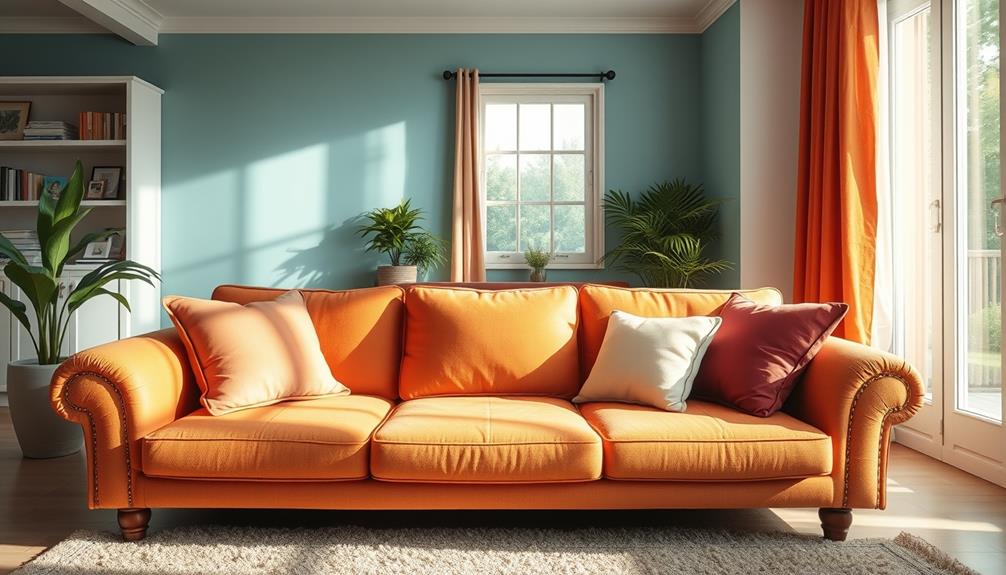
Deep cleaning your sofa offers several key benefits that can transform your living space. First off, it greatly improves indoor air quality by removing dust, allergens, and pollutants that accumulate over time. This boosts your home's cleanliness and creates a healthier environment for you and your family.
Additionally, using a vacuum specifically designed for dust removal, such as those listed in the Best Vacuums for Dust Removal in 2024, can enhance the effectiveness of your cleaning routine.
Moreover, a thorough deep cleaning restores your sofa's aesthetics, making it look fresh and inviting. You'll love how a clean sofa can enhance the overall appearance of your living area, making it more comfortable for lounging or entertaining guests.
Regular deep cleaning also preserves the value and longevity of your upholstered furniture. By maintaining the fabric's integrity, you prevent premature wear and tear, ensuring your investment lasts longer.
Additionally, professional deep cleaning services tackle tough stains, odors, dirt, bacteria, and even mold, promoting overall hygiene in your home.
Investing in these services not only saves you time and effort but also guarantees that your sofa receives the attention it needs to stay in great shape.
Essential Cleaning Supplies
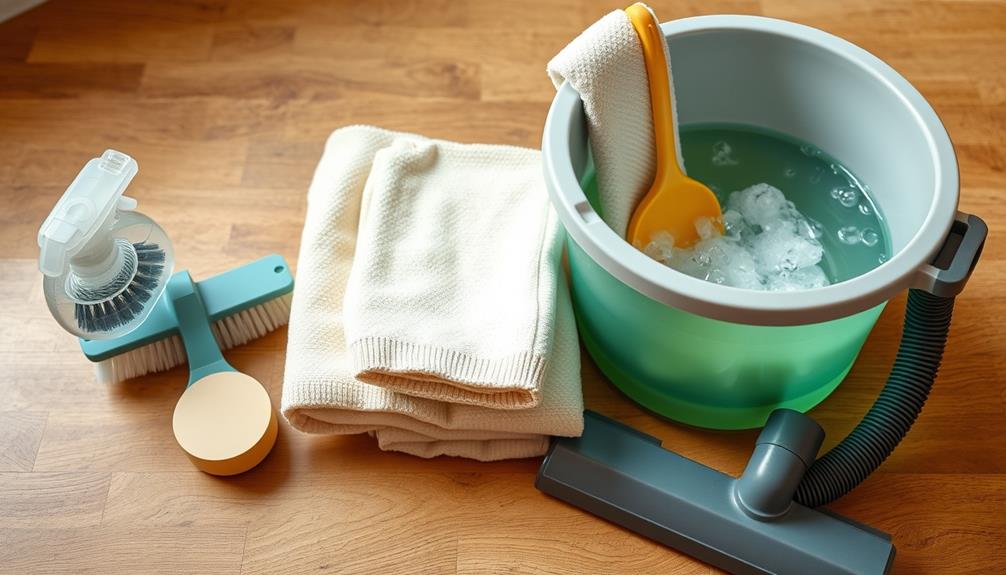
To effectively deep clean your sofa, you'll need the right cleaning supplies on hand. Start with a vacuum cleaner equipped with an upholstery attachment. This tool's vital for removing dust and debris from both the fabric's surface and those hard-to-reach crevices.
Regular cleaning of your furniture can help prevent the buildup of allergens and dust mites, which is especially important for households with pets or allergies. Additionally, consider the importance of a proper diet for your pets, as it can impact the cleanliness of your living space, reflecting how pet care is intertwined with home maintenance (Ultimate Hamster Care Guide).
Next, consider using baking soda. Sprinkling it on your sofa and letting it sit for 20-30 minutes helps absorb odors, leaving the fabric feeling fresh. For deeper stains, a handheld steam cleaner or an upholstery cleaning machine, like the Bissell Little Green Pro, can work wonders by penetrating the fabric fibers and lifting tough stains.
You can also create a DIY cleaning solution with items you likely have at home. Combine 2 cups of distilled water, 2 tablespoons of clear Dawn dish soap, and 2 tablespoons of distilled white vinegar for a gentle yet effective cleaner.
Lastly, don't forget about microfiber cloths! These are essential for applying your cleaning solution and blotting stains, as they're gentle on fabrics and help prevent color bleeding or damage during the cleaning process.
With these supplies, you're ready to tackle your sofa's deep cleaning!
Preparing the Sofa
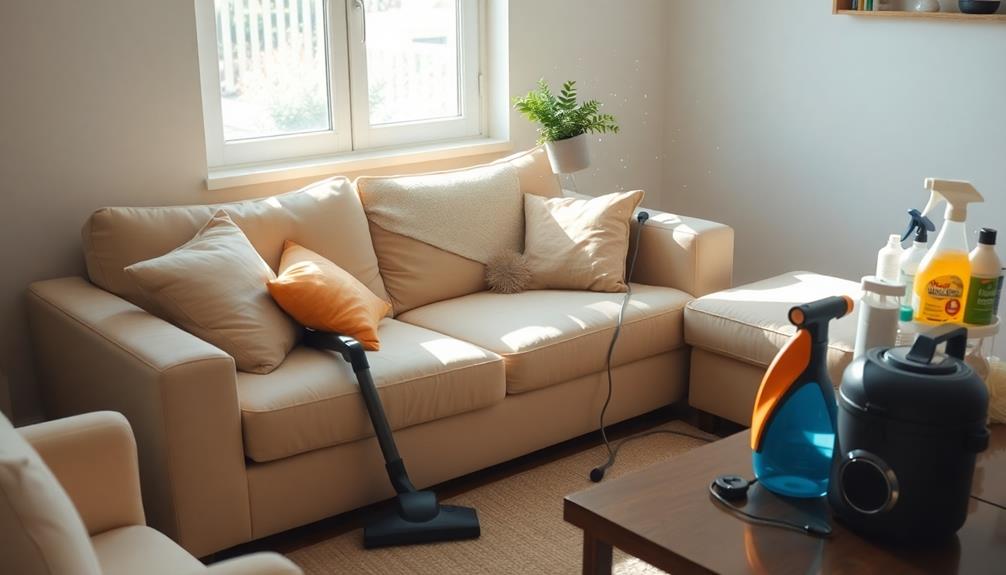
Before you start deep cleaning your sofa, clear the surface by removing all cushions and loose items.
It's important to evaluate the cleaning method that suits your sofa fabric, as different materials may require varying techniques, similar to how professional cleaning services handle delicate fabrics.
Make sure to check the fabric care codes on the manufacturer's tag to understand any specific cleaning instructions.
Once that's done, gather your cleaning supplies so you're ready to tackle the job efficiently.
Clear Sofa Surface
Preparing your sofa for a thorough deep clean starts with clearing the surface.
Begin by removing all items from the sofa, including cushions, blankets, and any decorative elements. This creates a clear sofa surface, allowing you to work efficiently and effectively. Once the sofa is cleared, take this opportunity to inspect the structure for any dust or hidden debris. Clean the surface thoroughly, ensuring it’s ready for use, whether for sitting or transforming into a bed. If you’re wondering how to pull out a sofa bed, simply locate the handle or pull strap typically found between the seating cushions, then gently lift and pull it towards you to extend the bed frame.
It's also a good idea to reflect on the impact of indoor air quality on your cleaning process, as dust and allergens can settle on your furniture. For instance, using an air purifier can help improve air quality as you clean by reducing airborne particles and allergens that may have accumulated over time, so you might want to maintain efficient air purification.
Next, check for any removable cushion covers. If your sofa has them, take them off according to the manufacturer's instructions for separate cleaning. This step is essential, as it helps guarantee that the cushions are cleaned properly without damaging the fabric.
After that, it's time to vacuum the entire sofa.
Focus on crevices, seams, and under the cushions to remove dust, debris, and pesky pet hair. A thorough vacuuming will help you get rid of the dirt that's accumulated over time.
Check Fabric Care Codes
Checking the fabric care code on your sofa is fundamental for a successful deep clean. This code, usually found on a tag, tells you which cleaning methods are safe for your specific fabric. Common codes include "W" for water-based cleaners, "S" for solvent-based cleaners, "W/S" for either type, and "X" for vacuuming or brushing only.
For those looking to maintain a clean living environment, understanding proper cleaning techniques is essential, as improper methods can lead to long-term issues, such as damage and dirt retention. It's also worth considering natural remedies alongside conventional methods to enhance your cleaning process.
Using the wrong cleaning method can result in damage like color bleeding or fabric deterioration, so it's important to know what you're working with. If your sofa has a "W" code, you're in luck; you can use mild soap solutions or steam cleaning. On the other hand, if it's marked with an "S," stick to dry cleaning solvents.
Regardless of the code, always conduct a spot test on a hidden area before you apply any cleaning solution to the entire sofa. This guarantees that the fabric reacts well and prevents any unwanted surprises.
Gather Cleaning Supplies
To kick off your deep cleaning process, gather all the essential supplies you'll need to tackle your sofa effectively. Start with a vacuum cleaner equipped with an upholstery attachment to remove loose dirt and debris.
Understanding the unique charm that comes from a well-maintained space can motivate you to keep your furniture looking fresh. Next, grab some baking soda for odor absorption and an upholstery cleaner that matches your fabric care code. This guarantees you won't damage your sofa while cleaning.
If you want to create a DIY cleaning solution, mix 2 cups of distilled water, 2 tablespoons of clear Dawn dish soap, and 2 tablespoons of distilled white vinegar in a spray bottle. This mixture works wonders for deep cleaning.
You'll also need a firm-bristled brush to loosen stubborn dirt before vacuuming. Additionally, gather clean, lint-free cloths for blotting any stains and drying your sofa afterward. Using a damp cloth is ideal for this purpose, as it helps lift stains without leaving residue behind.
Cleaning Different Fabrics
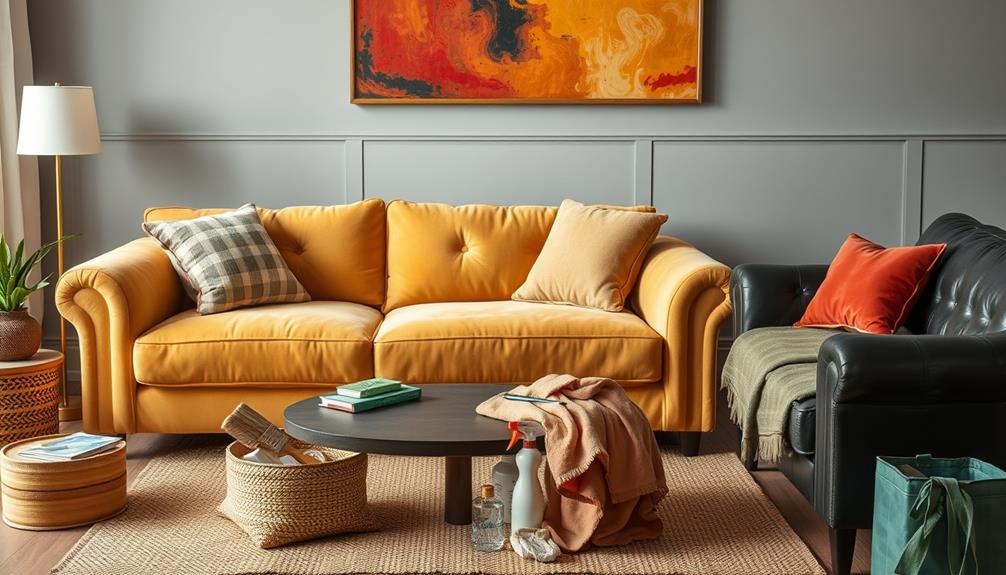
When it comes to cleaning different fabrics on your sofa, understanding the material is key to effective maintenance. Each type of upholstery requires specific techniques to tackle stubborn stains and keep your sofa looking its best.
Additionally, exploring the right tools and methods can enhance your cleaning experience and efficiency, much like optimizing a well-structured music production workflow.
Here's a quick guide to help you through it:
- Cloth Couch: Start by brushing to loosen debris, then sprinkle baking soda for odor absorption. Use a DIY cleaner made of dish soap, vinegar, and water, gently dabbing at stains before letting it air dry.
- Microfiber Couch: Fill a spray bottle with rubbing alcohol. Lightly scrub stained areas and fluff the fabric with a dry brush afterward to restore texture.
- Suede Couch: Avoid water. Instead, use a soft brush and a specialized suede cleaner for stains. Blot carefully and let it dry naturally to avoid damage.
- Velvet Couch: Absorb any moisture with paper towels, lift solid stains with a butter knife, and apply a detergent solution. Finish with steam cleaning to remove wrinkles and maintain the fabric's appearance.
Techniques for Stain Removal
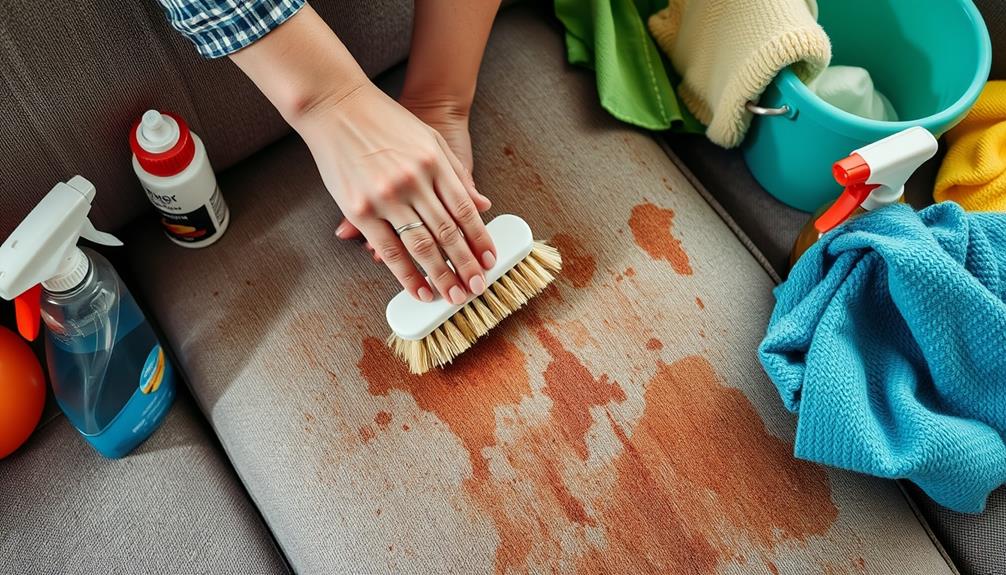
When it comes to stain removal, knowing the type of stain is essential for effective cleaning. Different stains, like water, grease, or pet accidents, require specific techniques and solutions to tackle them properly.
For instance, if your sofa has absorbed a food-related stain, it's important to take into account the high sugar content in those substances, as it can make the stain stickier and harder to remove.
Additionally, using pet-friendly options can be beneficial if you have furry friends at home.
Let's explore the best methods to guarantee your sofa looks its best again.
Common Stain Types
Sofas often face a variety of common stains that can mar their appearance, including food spills, drink mishaps, and dirt from pets or shoes. Knowing the types of stains you might encounter can help you tackle them effectively.
Additionally, being aware of how some food items, like sugary candies, can leave sticky residues, is important for prevention and cleaning high sugar content candies.
Here are four common stain types to watch out for:
- Food Spills: Sauces, crumbs, and other food items can leave unsightly marks.
- Drink Mishaps: Beverages like coffee and soda can easily cause stains that may require prompt attention.
- Pet Stains: Pets can bring in dirt, hair, and sometimes accidents that need special cleaning solutions.
- Water Stains: These can happen from condensation or spills, often requiring a vinegar and water mixture for treatment.
Each type of stain has its specific treatment method. For instance, food and pet stains often need enzyme cleaners, while water stains can be treated with a mixture of white vinegar and distilled water.
Always remember to conduct a spot test on an inconspicuous area before applying any cleaning solution to avoid discoloration or damage.
Effective Removal Techniques
After identifying the common stains that can affect your sofa, it's time to tackle effective removal techniques tailored to each type. Here's a quick reference table to help you with cleaning different fabrics.
| Stain Type | Removal Technique |
|---|---|
| Water Stains | Mix ½ cup white vinegar with 2 cups distilled water, lightly mist, and blot with a microfiber cloth. |
| Grease Stains | Combine 1 teaspoon dish soap with 2 cups of water. Apply and blot gently to lift the stain without damaging the fabric. |
| Cloth Couches | Use a DIY cleaner made of dish soap, vinegar, and water. Dab the stain with a soft cloth and let it dry. |
| Microfiber Couches | Spray rubbing alcohol on the stained area, scrub gently, and fluff the fabric with a dry brush. |
For suede couches, use a soft brush and suede cleaner, avoiding water. Remember, always blot stains instead of rubbing them to prevent damage. By following these techniques, you'll effectively remove stains and restore your sofa's appearance.
Addressing Odors Effectively
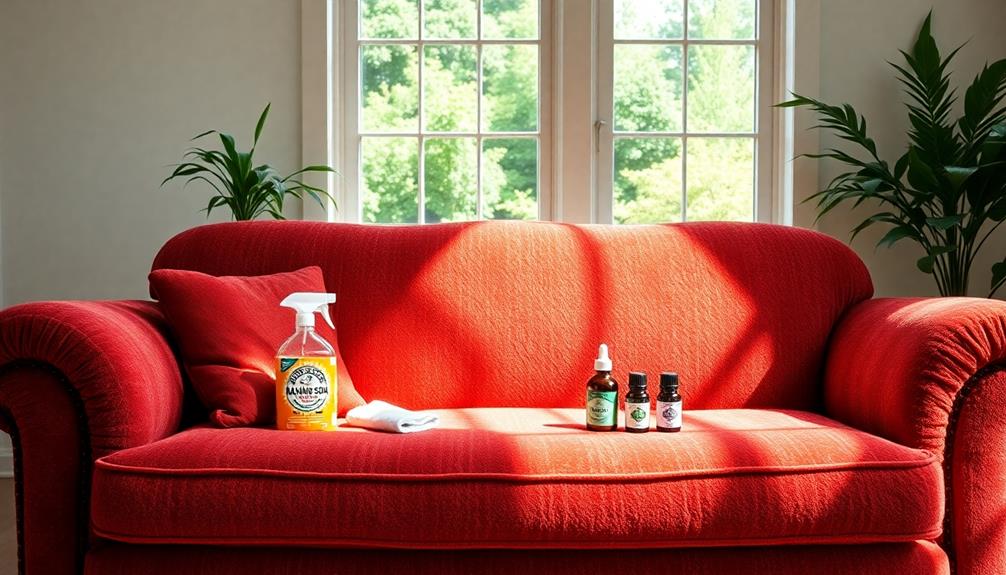
A fresh-smelling sofa can transform your living space, making it more inviting and comfortable. To effectively tackle odors, here are some steps you can take:
1. Baking Soda: Sprinkle baking soda generously on the fabric and let it sit for 1-2 hours. This will absorb unwanted smells. Afterward, vacuum it off for a refreshed scent.
Additionally, maintaining a clean environment is vital for preventing odors in the first place; consider utilizing resources from financial considerations for elderly care to help manage cleaning expenses if needed.
2. Fabric Sprays: Use fabric sprays like Febreze FABRIC to target specific odors from food, pets, or spills. This quick fix can instantly uplift your sofa's smell.
3. Regular Maintenance: Freshen your couch immediately upon detecting odors. This proactive approach prevents smells from becoming entrenched in the fabric.
4. Enzyme Cleaners: For persistent odors, consider using enzyme cleaners. These break down organic materials, making them particularly effective for pet-related smells.
Always guarantee proper ventilation in the cleaning area; it helps dissipate odors more quickly during and after the cleaning process.
Professional Cleaning Services
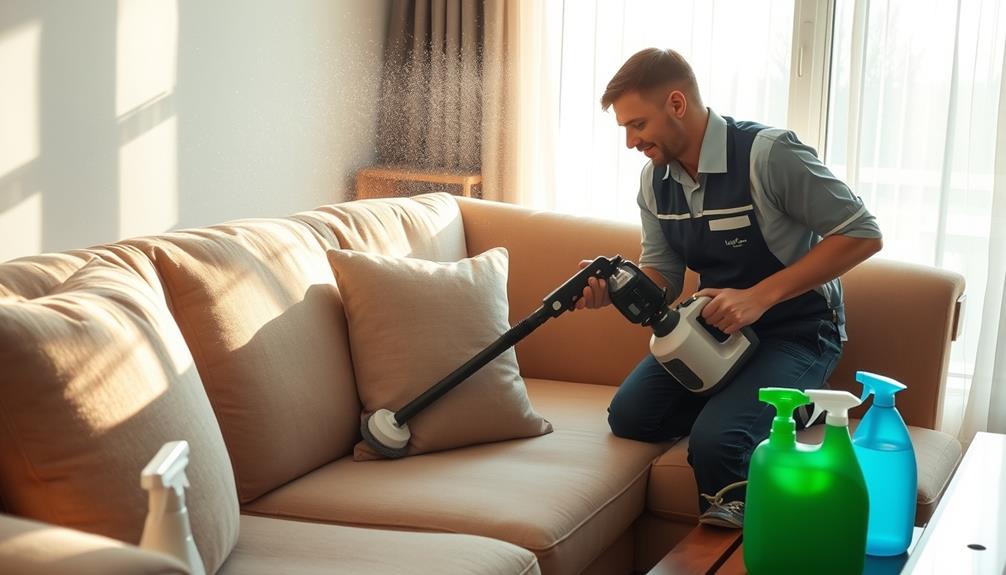
For a deeper clean that goes beyond simple maintenance, professional cleaning services offer an effective solution. Companies like Molly Maid specialize in revitalizing your upholstered furniture, utilizing advanced equipment and techniques to remove dirt, allergens, and stubborn stains. This not only enhances the appearance of your sofa but also prolongs its lifespan.
Molly Maid provides tailored cleaning options that you can schedule regularly, occasionally, or for special events, making it easy to fit into your routine. With over 450 franchises across the U.S., finding local help for your cleaning needs is convenient.
You can trust their expertise, as they completed 1.7 million cleaning services last year, with 90% of customers choosing to use their services again. This statistic emphasizes their reliability and effectiveness in the industry.
What sets Molly Maid apart is their Done Right Promise, ensuring customer satisfaction and peace of mind. When you opt for professional cleaning services, you're not just investing in a cleaner sofa; you're securing a commitment to quality service that meets your expectations.
Maintenance Tips for Sofas
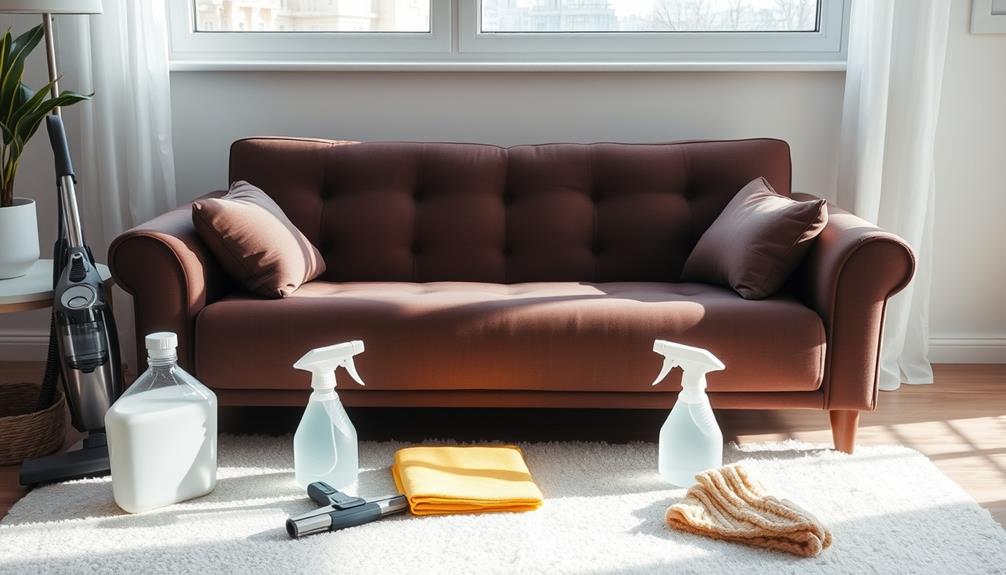
Maintaining your sofa's cleanliness and appearance is essential for keeping it looking its best and extending its lifespan.
Implementing a few simple maintenance tips can make a significant difference. Here are some effective strategies to take into account:
- Vacuum Weekly: Make it a habit to vacuum your sofa at least once a week. This removes dust, dirt, and pet hair, enhancing both its appearance and hygiene.
- Use a Lint Roller: For quick cleanups, keep a lint roller or damp cloth handy. It's perfect for removing small debris and pet hair between deep cleanings.
- Rotate and Fluff Cushions: Every few months, rotate and fluff your cushions. This helps promote even wear and maintains their shape, which can extend your sofa's lifespan.
- Spot Treatment: Act swiftly with spot treatment for spills. Use a suitable cleaner immediately to prevent stains from setting, keeping your fabric looking fresh.
Final Touches and Care
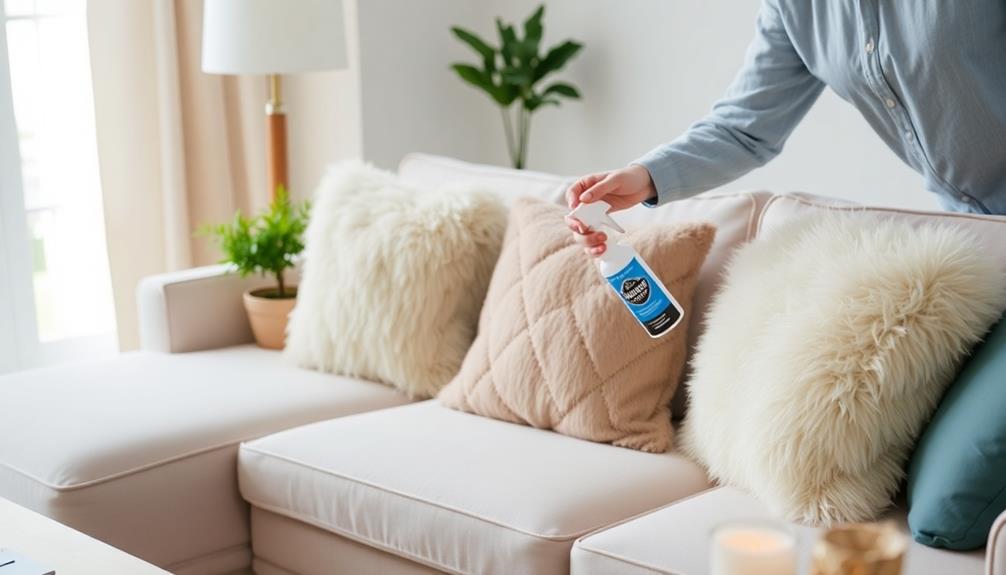
After deep cleaning your sofa, giving it the right final touches can enhance both its appearance and longevity.
Start by allowing your sofa to air dry completely. This step is essential to prevent moisture buildup, which can lead to mold or mildew growth. While your sofa is drying, consider applying a fabric deodorizer or sprinkling baking soda on the cushions to absorb any lingering odors. After letting it sit for a while, vacuum off the baking soda for a fresh scent.
Next, regularly fluff and rotate the cushions to promote even wear and maintain the sofa's shape. This simple habit can extend the life of your furniture greatly.
If you have removable covers, store them in a cool, dry place when not in use and wash them according to the care instructions to keep them in good condition.
Lastly, protect your newly cleaned sofa by applying a fabric protector that's suitable for your material. This will shield it from future stains while ensuring it doesn't affect the fabric's appearance.
With these final touches, your sofa won't only look great but also stand the test of time.
Frequently Asked Questions
How Do You Deep Clean a Couch by Yourself?
To deep clean your couch by yourself, start by vacuuming thoroughly. Then, mix a cleaning solution, treat stains, sprinkle baking soda, and consider using a steam cleaner for a fresh, revitalized look. It's simple!
What Is the Best Way to Clean a Fabric Sofa?
Ever wondered how to keep your fabric sofa looking fresh? Start by identifying the fabric type, regularly vacuuming, and using the right cleaning solution. Spot test first, then enjoy your revitalized, clean seating space!
Can a Sofa Be Deep Cleaned?
Yes, you can deep clean a sofa. It helps remove dirt and allergens, enhancing your indoor air quality. Regular deep cleaning every six months keeps it looking fresh and extends its lifespan.
How Do You Deep Clean and Sanitize a Couch?
To deep clean and sanitize your couch, start by vacuuming thoroughly. Then, use a fabric-safe cleaner or a DIY solution, spray it on, and let it dry completely to guarantee freshness and prevent mold.
Conclusion
Deep cleaning your sofa can transform it from a dingy, neglected piece of furniture into a fresh, inviting centerpiece for your living space. While it may seem challenging, the rewards of a clean sofa—like improved air quality and enhanced comfort—far outweigh the effort involved. By following the right techniques and maintaining your sofa regularly, you'll not only extend its life but also create a welcoming atmosphere in your home. So go ahead, rejuvenate your sofa today!
